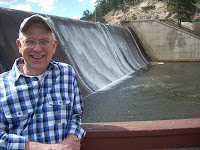I did like games of simulation. The former were based on beating
others—winning. My early aversion arose most likely from my lack of physical
strength and coordination combined with my weak skills in strategizing. If I
ran a race, I simply ran. The problem was that I ran too slowly. I couldn’t
throw balls far or fast and the balls rarely showed up where I thought I was
throwing them. At the shooting range I couldn’t see very well even though I had
no idea of that. Then when I got corrective lenses I never could figure out how
to compensate. I had a hard time concentrating on activities that didn’t
capture my imagination.
basketball, but I wasn’t even a good basketball player. I wasn’t aggressive
enough and didn’t care to be better than the other guys. But growing up I did
like games like War, Cops and Robbers, and my favorite, Cowboys and Indians. I
probably liked the costuming, props, and improvisatory acting. I was especially
repelled by party games—games like Pin the Tail on the Donkey, or dropping
clothes pins into milk bottles. I could play cards: War, Canasta, Gin Rummy, Pinochle,
Poker, and Pitch, but I abhorred spin the bottle. I wasn’t interested to kiss
anyone (well until 10th grade when I learned to kiss Buddy).
outbreak of the Learning Games Movement. Some of these were pretty awful and
met strong resistance particularly from adult groups. I did like the Simulation
Games—an accommodation of military training practices used to introduce
students to strategic thinking as related to their topics of study. (It seems
strange that I liked them given their origins!) Of course school teachers had
long used competitive games like spelling bees and other more complicated ones
like debate. Even in my high school years church youth rallies sported television
game-show-inspired competitions over biblical knowledge pitting teams from
neighboring churches. Although I knew the Bible pretty well, I never was
interested to use the knowledge for purposes of showing off. It seemed somehow
antithetical to the sense of charity or cooperation I learned from the Good
Book’s best teachings. And remember, I was not very competitive.
introducing cooperative games strategized to create community—Hippie-inspired group
play that featured Earth Balls and sometimes flowers. I started developing similar
games—both the New Games and Simulations—for youth retreats and elementary
residential camps, ones related directly to the curricular themes and that
often involved the creation of environments, for example, a simulated
archaeological dig or a Middle-Eastern marketplace. These were much more
related to the simulation games of childhood than they were to sporting events,
and they proved effective in teaching.
human life—either that of an individual or of a group. Still I do appreciate
the grace and power of athletes. I also like a couple of card games that have
so little strategy as not to stifle conversation among the players. But I don’t
like playing even those games with players who take winning too seriously.
will admit to enjoying the Christmas games my youngest granddaughters planned
for our family. They involved individuals and teams. My favorite was the Reindeer
Game. For my team I hurriedly blew up and tied off small balloons until I was
out of breath and feeling very light headed. The balloons were then stuffed
into panty hose. The team that first successfully filled the legs like antlers
and whose reindeer donned them first won. Selected for the honor of being the
reindeer were my son Michael and his wife Heather. They looked bizarrely cute,
but my favorite part of that game was my daughter Desma’s story of trying to
purchase panty hose. Suppliers have become rare. Finally she found a store that
still carries them. The clerk said, “Yes, we have them. You must be going to
play the Reindeer Game; it’s all the rage at the State workers’ office parties
this year. You got here just in time.” Handing Desma the hosiery she said, “Here
are the last two pair.”
lives in Denver and spends his time writing, painting, and socializing. In
general he keeps busy with groups of writers and artists. Following thirty-two
years in church work and fifteen in a therapeutic massage practice, he now
focuses on creating beauty. He volunteers at The Center leading the SAGE
program “Telling Your Story.”

